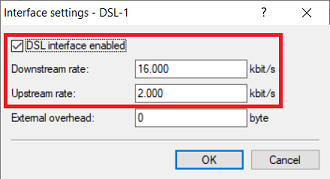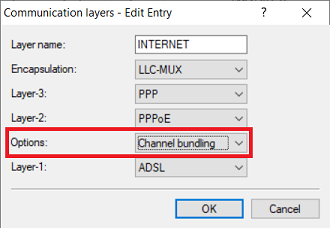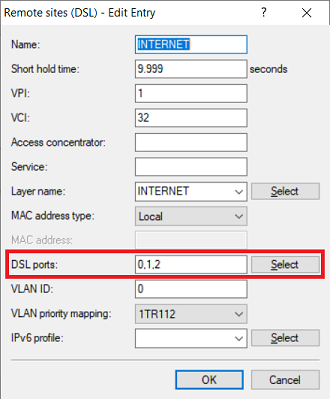Description: In many cases the bandwidth of a single DSL connection will not meet your needs. If the provider has no way of increasing the speed of the DSL connection, additional Internet connections will be required. To optimize data transmission, it is possible to bundle two or more DSL connections by means of MLPPPoE (Multilink PPPoE). This document describes the channel bundling of multiple DSL lines by employing MLPPPoE in LANCOM routers. 1) Using a router with an integrated ADSL/VDSL modem: - Two external modems and the internal DSL modem are to be operated with MLPPPoE channel bundling.
- Three DSL 16000 connections are available.
2) Using a router without an integrated ADSL/VDSL modem: - Three external DSL modems are to operate with MLPPPoE channel bundling.
- Three DSL 16000 connections are available.
Procedure: The configuration is basically the same for both scenarios. A few parameters are configured differently for the scenario without an integrated DSL modem.
1) Using a router with an integrated ADSL/VDSL modem:
1.2) Open the configuration for the router in LANconfig and switch to the menu item Interfaces → LAN → Ethernet ports . 1.3) Assign one DSL port each to two Ethernet ports so that the two external DSL modems can be connected to them (in this example, the interface DSL-1 is assigned to the port ETH1 and the interface DSL-2 is assigned to the port ETH2). 1.4) Navigate to the menu Interfaces → WAN → Interface settings . 1.5) Adjust the interface settings for the DSL interfaces assigned in step 1.3 as follows: Interface settings - DSL-1: - Make sure the checkmark is set for DSL interface enabled .
- Downstream rate: Set the download bandwidth of the Internet connection.
- Upstream rate: Set the upload bandwidth of the Internet connection.

Interface settings - DSL-2: - Set a checkmark for DSL interface enabled .
- Downstream rate: Set the download bandwidth of the Internet connection.
- Upstream rate : Set the upload bandwidth of the Internet connection.
1.6) Switch to the menu Communication → General → Communication layers . 1.7) Edit the communication layer created by the Setup Wizard in step 1.1 (in this example the layer INTERNET) and adjust the following parameter: - Options: From the drop-down menu, select Channel bundling .

1.8) Switch to the menu Communication → Remote sites → Remote sites (DSL). 1.9) Edit the remote site created by the Setup Wizard in step 1.1 (in this example the layer INTERNET) and adjust the following parameter: - DSL ports : Set the DSL interfaces used by the integrated DSL modem (in this case 0) and by the external DSL modems (see step 1.3).

1.10) This concludes the configuration. Write the configuration back to the router.
2) Using a router without an integrated ADSL/VDSL modem: The settings described in the following differ from those in scenario 1. 2.1) Use the Setup Internet access wizard to install the Internet connection. 2.2) In the menu Interfaces → LAN → Ethernet ports , assign one DSL interface each to three Ethernet ports. 2.3) Activate the DSL interfaces assigned in step 2.2 in the menu Interfaces → WAN → Interface settings and set the upstream and downstream rates. 2.4) In the menu Communication → General → Communication layers , adjust the layer created by the Setup Wizard in the step 2.1 (in this example the layer INTERNET): - Options: From the drop-down menu, select Channel bundling.

2.5) In the menu Communication → Remote Sites → Remote sites (DSL), adjust the remote site created by the Setup Wizard in step 2.1 (in this example the remote site INTERNET): - DSL ports : Set the DSL interfaces used for the external DSL modems (see step 2.3).
|